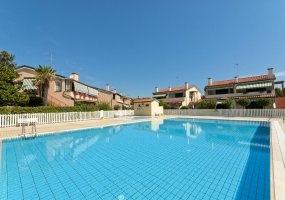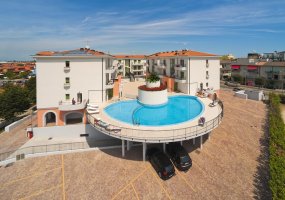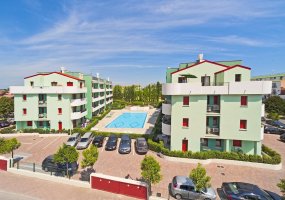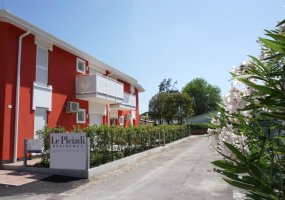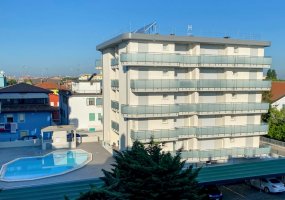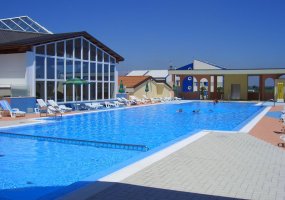The history of Caorle and its origins
The discovery in the hamlet of San Gaetano, of a protohistoric village dating back to the Bronze Age, has confirmed the existence of settlements in prehistoric times in the nearby countryside. But the origins of Caorle (in the past called Caprulae, Bella Petronia, Insula Capritana or Caule) date back to the first century BC, as evidenced by numerous findings dating back to Roman times, such as:
- Ara Licovia (which belonged to the Licovia gens), a funerary altarpiece in limestone, now the base of the altar of the Blessed Sacrament, in the left side apse of the Cathedral;
- ara of the sailor Batola, found near the Cathedral of Caorle, currently kept in the Museum of Concordia Sagittaria and dating back to the first or second century. A.D.;
- numerous archaeological finds in the sea, including a Roman anchor in lead, weighing about 200 kg, datable between the second century. B.C. and II. A.D., which belonged to a large boat, today preserved in the archaeological museum of Caorle.
In Roman times, thanks to its strategic position near the mouth of the river Livenza from which it reached the important Roman center of Opitergium, Concordia and Aquileia, the city was certainly a center of intense traffic both sea and river, as evidenced by the finding in sea depths of Caorle of a Roman ship of the first century A.D. carrying a load of amphorae probably containing wine.
Some historical testimonies refer to the year 238 A.D., when the Romans presided over the "caprulane" waters with their naval fleet to defend themselves from Maximinus.
After the invasions of the barbarians who put to fire Aquileia, Concordia, Oderzo, Altino and Padua and the definitive fall of the Roman Empire in 476 A.D., the lagoon of Caorle became a place of refuge for the inhabitants of the hinterland.
This migration brought about a notable increase in the population that needed an adequate government structure and in 480 A.D. a sort of local self-government exercised by the tribunes was established.
The economy was based on fishing, the salt trade, the cultivation of vegetables and the manufacture of ships, and in fact, in 538 A.D., Senatore Cassiodoro, Prefect of the Theodoric King, turned to the Caorle squeri for transport vessels.
In 876 A.D. the "Insula Capritana" was erected the Episcopal Seat. Around 900 A.D. Caorle joined the Republic of the Serenissima, to whose development he contributed with men and means, as in 1570, when Venice waged war on the Turks and Caorle provided two galleys with 70 sailors each.
During the Venetian period, the city was governed by the Major Assemblies of the Maggior and Minor Arengo and its territory was part of the Dogado and was one of the 9 districts in which the administration was subdivided, governed by a “podestà”.
Moreover, it constituted one of the 10 regiments in which the dogado was subdivided.
The flourishing commerce of the island allowed the construction of the Cathedral (1038) on a pre-existing early Christian basilica, whose remains are still preserved inside the cathedral, in the adjoining museum, in the gardens of the parsonage and the Cilindric Bell Tower (1070) ).
Memorable was the episode, in the tenth century, of the rape of some Venetian maidens by the Dalmatian pirates, freed right on the beach of the town, thanks to the intervention of the Venetian fleet led by doge Pietro Candian II.
In the thirteenth and fourteenth centuries, due to the frequent invasions of the territory by the Triestines and pirates for which many families were forced to move to Venice and the famines and pestilences that decimated the population, Caorle began to lose importance compared to other cities of the Venetian dogado.
In 1379, the Genoese landed on the island and while trying to conquer the territories of the Serenissima, devastated the city, forcing the bishops to leave the vacant episcopal seat.
Now decayed, Caorle became a Commune under the Reign of Italy (1806-1815) by Napoleon Bonaparte, who reduced its borders to Torre di Mosto and S. Stino di Livenza.
In 1807, after a thousand years, a Napoleonic decree suppressed the bishop's residence in Caorle, which hosted 57 Bishops from Leone to Giuseppe Maria Peruzzi.
In 1818 the diocese was suppressed, and the territory was annexed to the patriarchate of Venice, thus losing many of the popular and religious traditions that had animated the life of the island in previous centuries.
During the Lombard-Veneto Kingdom (1816-1866), there was a slow economic recovery, thanks to a better use of the arable land and the free use of quinine, the only anti-malar then available, which rehabilitated the lagoon and allowed a population increase. In 1854 the Consorzio Peschereccio was established, which united and organized the local fishermen, in order to regulate the fishing activity. In 1866 it was annexed to the Kingdom of Italy.
From the twentieth century to today
With the defeat of Caporetto, the territory of Caorle became strategic for the front that fought on the Piave and in the last offensive of 1918 also the caorlotti were honored, so that the citizen Giorgio Romiati founded the association "Giovane Italia", awarded the silver medal to military valor after the November victory.
After the end of the First World War, work began on the reclamation of the surrounding marshes, which became very rich fishing areas (fishing valleys) and arable land and many rural settlements arose in the hinterland that became important agro-food production activities, craftsmanship, manufacturing, etc.
In 1935 the "Sebastiano Chiarello" Lungomare dike and the Rio Terrà reservoir were completed (until the last century the historic center of Caorle was in fact crossed by canals, later buried).
In this period the most important buildings were built, such as the "Andrea Bafile" elementary school, the Carabinieri barracks, the New Town Hall, the civil status office, etc ..., the fish trade flourished (there were about 300 fishermen that ruled 28 “bragozzi” and other 172 fishing boats) and began also the tourist activity while on the west beach arose the Baths Turchetto Establishment.
With the beginning of the second world war, the economy of Caorle was again arrested due to the prohibition of fishing at sea due to the danger of bombing.
The Germans threatened to flood, for strategic reasons, the entire coast for a depth of 10 kilometers but the alarm came unexpectedly, and even today the caorlotti, in memory of a vote issued on 2 January 1944, attribute the merit to the intercession of the Madonnina del Mare.
Since the 60s the number of tourists has increased, beginning a new economy based mainly on tourism.
The lagoon of Caorle was frequented in the '50s and' 60s by the great American writer Ernest Hemingway, guest of the Venetian baron Raimondo Franchetti, who in this corner of wild nature found inspiration for his famous novel "Across the river and into the trees".
To cope with the new urban planning requirements, a series of public works were undertaken, such as the asphalting of the streets and squares, the pavement of the sidewalks and the campielli, the construction of hotel complexes in the east and west beaches and of the Santa Margherita Campsite.
In the '70s was born Porto Santa Margherita, a nautical-residential area, with a very large dock.
Today Caorle, with Porto Santa Margherita, Duna Verde and the recent Lido Altanea, although it has become a modern tourist center known throughout Europe, has retained the original characteristics of a fishing village, linked to ancient traditions, which fascinates tourists with its history, its colors and its flavors.

